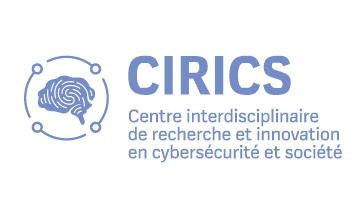

de Recherche et d’Innovation
en Cybersécurité et Société
Welcome
If needed, this section can contain some or all of the following:
- A large, engaging image of the university, department, or an abstract representation of the academic field can set a professional and inspiring tone.
- A brief welcome message or introduction that explains what visitors will find on the page. This could be a short paragraph detailing the purpose of the page, such as highlighting the academic and research achievements of the faculty.
- Key facts, achievements or statistics about the professor or department. For instance, number of published papers, years of experience, key projects, or awards won.
- Interactive timeline that highlights major milestones, such as significant publications, awards, and other achievements.
- A short video where the professor introduces themselves and talk about their work and interests providing a personal touch, and making the page more engaging and approachable.

Patrice Renaud
Professor
Université du Québec en Outaouais (UQO)
Department of Psychoeducation and Psychology
Patrice Renaud, Head of Cybersecurity and Individuals, is a full professor at the Université du Québec en Outaouais, where he co-directs the Cyberpsychology Laboratory. He is also a full researcher at the Institut National de Psychiatrie Légale Philippe-Pinel, where he is director of the Laboratoire Immersion Forensique. His research interests concern human-machine interactions in forensic psychology, with a particular focus on virtual technologies and their impact on sexual behavior.
Productions included in the research:
AUT (Other), BRE (Patent), CAC (Refereed publications in conference proceedings), CNA (Non-refereed paper), COC (Contribution to a collective work), COF (Refereed paper), CRE, GRO, LIV (Book), RAC (Refereed journal), RAP (Research report), RSC (Non-refereed journal).
Year: 1975 to 2024
Selected publications
2025 |
Brideau-Duquette, M.; Côté, S. S. -P.; Boukhalfi, T.; Renaud, P. Forensic Psychiatry and Big Data: Towards a Cyberphysical System in Service of Clinic, Research and Cybersecurity Proceedings Article In: B., Boulay; T., Di Mascio; E., Tovar; C., Meinel (Ed.): International Conference on Computer Supported Education, CSEDU - Proceedings, pp. 856–864, Science and Technology Publications, Lda, 2025, ISBN: 21845026 (ISSN); 978-989758746-7 (ISBN), (Journal Abbreviation: International Conference on Computer Supported Education, CSEDU - Proceedings). @inproceedings{brideau-duquette_forensic_2025,The advent of big data and artificial intelligence has led to the elaboration of computational psychiatry. In parallel, great progress has been made with extended reality (XR) technologies. In this article, we propose to build a forensic cyberphysical system (CPS) that, with a data lake as its computational and data repository core, will support clinical and research efforts in forensic psychiatry, this in both intramural and extramural settings. The proposed CPS requires offender's data (notably clinical, behavioural and physiological), but also emphasises the collection of such data in various XR contexts. The same data would be used to train machine and deep learning, artificial intelligence, algorithms. Beyond the direct feedback these algorithms could give to forensic specialists, they could help build forensic digital twins. They could also serve in the fine tuning of XR usage with offenders. This paper concludes with human-centered cybersecurity concerns and opportunities the same CPS would imply. The proximity between a forensic and XR-supported CPS and social engineering will be addressed, and special consideration will be given to the opportunity for situational awareness training with offenders. We conclude by sketching ethical and implementation challenges that would require future inquiring. Copyright © 2025 by SCITEPRESS - Science and Technology Publications, Lda. |
Brideau-Duquette, M.; Côté, S. S. -P.; Charbonneau, P.; Renaud, P. When Sexy Avatars Get Weird: How Brain Asymmetry and Oculomotor Dynamics Navigate the Uncanny Proceedings Article In: S., Itthipuripat; G.A., Ascoli; A., Li; N., Pat; H., Kuai (Ed.): Lect. Notes Comput. Sci., pp. 121–139, Springer Science and Business Media Deutschland GmbH, 2025, ISBN: 03029743 (ISSN); 978-981963293-0 (ISBN), (Journal Abbreviation: Lect. Notes Comput. Sci.). @inproceedings{brideau-duquette_when_2025,This study explores the psychological effects of human-machine interaction, particularly focusing on the phenomenon of the uncanny valley within the context of virtual reality (VR). This study specifically investigates the relationship between oculomotor dynamics, EEG asymmetry, and perceived uncanniness in an immersive setting with a realistic human avatar that can generate uncanny feelings. Participants engaged in a VR scenario designed to optimize their sexual interest. Eye-tracking and EEG data were collected during these interactions to assess the predictors of uncanniness. The final regression model identified significant predictors, including EEG asymmetry in frontal and parietal regions and nonlinear indices of gaze behavior. The findings suggest that the more a participants’ attention was attracted towards specific cues, the higher the uncanniness. The interplay between EEG asymmetries and gaze behavior furthermore indicates that these physiological and behavioral responses are closely linked to the perception of uncanniness, offering insights into how humans interact with increasingly lifelike technologies. These insights contribute to a better understanding of HMI’s potential and may inform the development of more engaging and psychologically attuned virtual content. © The Author(s), under exclusive license to Springer Nature Singapore Pte Ltd. 2025. |
2024 |
Horn, J. E. Van; Dongen, J.; Bouman, Y. H. A.; Wallinius, M.; Renaud, P. New Directions in Forensic Psychology: Applying Neuropsychology, Biomarkers and Technology in Assessment & Intervention Book Frontiers Media SA, 2024, ISBN: 978-2-8325-5531-6. BibTeX | Links: @book{van_horn_new_2024, |
Some Heading
If needed, this section can contain some or all of the following:
- Recent news, updates, or upcoming events related to the professor or their department, such as guest lectures, seminars, and conferences.
- Social media feed.
- A quote from the professor about their philosophy on education and research or a testimonial from a peer or student adding a personal and inspirational element to the page, placing this information just above the share icons can give visitors current and relevant reasons to engage and share.
- Call to Action to attend or participate in some even.
- Contact Form
- Subscribe form



